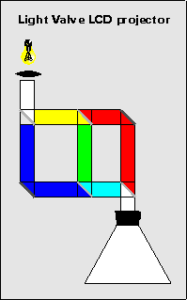A light valve (LV) is a form of optical switch which can be used to vary the amount of light which reaches a target (e.g. a screen) by deflecting the light from its path towards the target (a reflective LV) or by blocking the light-path (a transmissive LV).
They were first used in projection TVs and are now used widely in flat panel displays, data and video projectors and, increasingly, in rear projection monitors.
TI’s Digital Mirror-mirror Device (DMD) and Eidophor’s oil-film based system are examples of reflective light valves, while the Liquid Crystal Microdisplays are an example of a transmissive LV.
The DMD reflective LV varies the total amount of light reaching the target by switching, many times a second, between two states: one in which the light is reflected towards the screen and one in which it is reflected away. Humans aren’t very good at telling the difference between a constant light and one which is switched on and off very quickly, above a certain frequency, anyway (See VESA refresh-rate recommendations!). This is due to “persistence of vision”, a part of the human visual system which makes images linger for a short time in our brains. By varying the amount of time during each image frame which the light is reflected towards the target, the reflective DMD uses persistence of vision to give the illusion that the light is varying in brightness.
Transmissive light valves vary the amount of light reaching the target by blocking its passage in some way. The most common method is to use a polarising filter to polarise the light from the source in one direction and then passing it through a switching polarising filter, filled with liquid crystal, to block the path of any unwanted light. The grey scale of each pixel in a liquid crystal LV is controlled by varying the applied voltage. Therefore the pixel is switched only once during each image frame.

